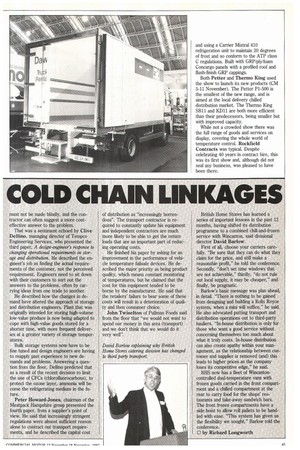COLD CHAIN LINKAGES
Page 47

If you've noticed an error in this article please click here to report it so we can fix it.
must not be made blindly, and the contractor can often suggest a more costeffective answer to the problem.
That was a sentiment echoed by Clive DeIlino, managing director of Tempco Engineering Services, who presented the third paper, A design-engineer's response to changing operational requirements in storage and distribution. He described the engineer's job as finding the actual requirements of the customer, not the perceived requirement. Engineers need to sit down with their customers to sort out the answers to the problems, often by carrying ideas from one trade to another.
He described how the changes in demand have altered the approach of storage and distribution engineers. Plant that was originally intended for storing high-volume low-value produce is now being adapted to cope with high-value goods stored for a shorter time, with more frequent deliveries at a greater variety of storage temperatures.
Bulk storage systems now have to be fine tuned and design engineers are having to reapply past experience to new demands and problems. Answering a question from the floor, Dellino predicted that as a result of the recent decision to limit the use of CFCs (chlorofluorocarbons), to protect the ozone layer, ammonia will become the refrigerating medium in the future.
Peter Howard-Jones, chairman of the Meatpack Hampshire group presented the fourth paper, from a supplier's point of view. He said that increasingly stringent regulations were almost sufficient reason alone to contract out transport requirements, and he described the capital cost of distribution as "increasingly horrendous". The transport contractor is required to constantly update his equipment and independent contractors are much more likely to be able to get the return loads that are an important part of reducing operating costs.
He finished his paper by asking for an improvement in the performance of vehicle temperature failsafe devices. He described the major priority as being product quality, which means constant monitoring of temperatures, but he claimed that the cost for this equipment tended to be borne by the manufacturer. He said that the retailers' failure to bear some of these costs will result in a deterioration of quality and then consumer choice.
John Twiselton of Pullman Foods said from the floor that "we would not want to spend our money in this area (transport) and we don't think that we would do it very well". British Home Stores has learned a series of important lessons in the past 12 months, having shifted its distribution programme to a combined chill-and-frozen service with Wincanton, said divisional director David Barlow.
First of all, choose your carriers carefully. "Be sure that they can do what they claim for the price, and still make a reasonable profit," he told the conference. Secondly, "don't set time windows that are not achievable," thirdly, "do not rule out local supply, it may be cheaper," and finally, be pragmatic.
Barlow's basic message was plan ahead, in detail. "There is nothing to be gained from designing and building a Rolls Royce system, when a mini will suffice," he said. He also advocated putting transport and distribution operations out to third-party hauliers. "In-house distribution is only for those who want a good service without concerning themselves too much about what it truly costs. 1n-house distribution can also create apathy within your management, as the relationship between customer and supplier is removed (and) this leads to higher prices as the company loses its competitive edge," he said.
BHS now has a fleet of Wmcantoncontrolled dual-temperature vans with frozen goods carried in the front compartment and a chilled compartment at the rear to carry food for the shops' restaurants and take-away sandwich bars. The front frozen compartments have a side hoist to allow roll pallets to be handled with ease. "This system has given us • the flexibility we sought," Barlow told the conference. 0 by Richard Longworth




































































































































